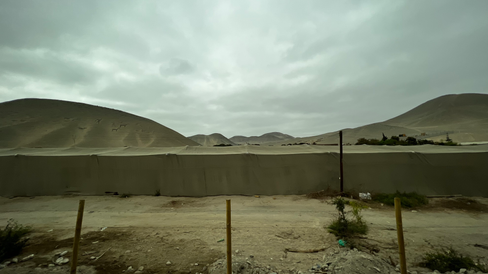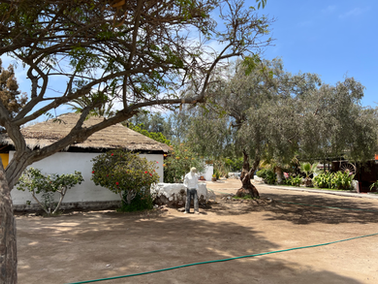Hurtigruten Pole to Pole - Week 11
- Sal Schmidt

- Oct 24, 2022
- 9 min read
Updated: Jun 14
Inca History, Colonial Highlights & the Panama Canal - Chile, South America
We arrive in Chile in week 11 of our 13-week Pole-to-Pole cruise on the MS Roald Amundsen with Hurtigruten Expeditions and explore the coast.
Day 71 - Arica, Chile
Country 60! We are certainly increasing the number of countries we've visited!
Today, we arrived in Arica, Chile's northernmost city, only 18 km from Peru. This port town, which has a population of 220,000, is surrounded by the Atacama Desert (also known as where fast fashion goes to die). Near the centre of Arica, a path climbs up to Morro Arica hill, with sweeping views over the coastline.
Upon arriving in Northern Chile, the landscape is a sea of arid scenery, the rich greenery we have left behind. You can feel the dust as you immerse yourself in the city and wonder about Summer; escaping is challenging.
We were fortunate to glimpse some of the desert drawings, such as the geoglyphs of the north Chilean desert.
We were on an excursion to taste the flavours of Arica. It started with a short drive out of the city via the coastline and the enormous centrepiece, a large rock, to delve deeper into the desert to visit a local olive and tomato farm.
After a quick stroll through the tomato vines and olive trees dating back over 100 years and a quick sample of homegrown olives, we enjoyed capturing some fun moments and settling into the peaceful oasis set up to soak up the morning sun.
Next, we visited the local farmers market; we enjoyed perusing all the fresh produce and purchasing a vibrant bunch of lilies (USD5) to bring some joy to our home, our suite on the ship.
A visit to a handicraft village followed the market, a replica of the Altiplanic town of Parinacota, located at 4390m high, and the commune of Putre, 200 km from Arica. We were offered a local Mango sour (incredibly sweet for our palate) and could peruse the craft shops. Due to the desolate atmosphere, we strolled quickly and rested on the bus.
Once all passengers were back on the bus, we had a quick opportunity to explore the centre of Arica, which was filled with walking streets and eateries, a lovely church, and a historic building that was the original customs house designed by French architect Gustave Eiffel in metal and wood.
We spent the afternoon relaxing on the ship, devouring more delights from Fredheim and spoilt by another magical sunset as we continued down the Chilean coastline to our next destination, Iquique.
Fun facts:
Pachamama is a goddess revered by the indigenous peoples of the Andes. In Inca mythology, she is an "Earth Mother" type goddess and a fertility goddess who presides over planting and harvesting, embodies the mountains, and causes earthquakes.
It does not rain in Africa; there is zero rainfall each year.
The Chinchorro mummies, the oldest mummies in the world, were recovered from the Atacama Desert near Arica and date back to around 7020 BCE.
Chile's coastline is 6,435 km (4,000 miles) long.
Day 72 - Iquique, Chile
It was an early arrival into port, so the ship was as quiet as a mouse, as everyone was out and about on their excursions when we surfaced at about 9 am. Due to only having half a day in port, we opted out of the excursions as we didn't want to miss out on experiencing the life of now in Iquique by attending the historical-themed tour of the ghost town Humberstone, a UNESCO site, an old mining town with an alarming and sordid history, or the city highlights tour with a guide.
Iquique is a coastal city in northern Chile, west of the Atacama Desert, home to 200k people. A prosperous saltpetre mining town in the 19th century, today it's a popular holiday destination due to its crystal clear Pacific beaches and Spanish-influenced seafront casino.
We did it Wayne and Sal style and made our way to the old city (via a complimentary shuttle bus; being in a working port, it isn't safe to wander into town on foot).
We were dropped five minutes from the port in the historic district by the iconic 19th-century clock tower in Arturo Prat Square, the city's central plaza.
We gave ourselves a high five as we were exactly where we had planned on foot, a beautiful pedestrian street called Baquedano. A walking street lined with shades of pastel-coloured colonial-era buildings, now all operating as bars, cafes and restaurants. The first cafe we spotted was where we ordered our morning coffee to continue our stroll through the beautiful street. The coffee was delicious, too! I think it was 4000 pesos, so USD 2 each. We made sure to withdraw local currency via an ATM in Arica to make life easier, although cards were accepted in most places.
We loved our morning walk. The weather was just below 20 degrees, so it was perfect. We enjoyed a sensational coffee and the coastal views as we reached the beaches.
Making our way back up Baquedano, we were hoping to visit a local barber. The last tidy-up was in Canada, so he looked a little shabby. He was closed. We had put our sights on a funky bar below the barber earlier, so it was now mojito time instead. I am sure it was noon somewhere!
We chatted away with our friendly bartender from Bolivia, listening intently to his inspiring story. His family immigrated to England, and of nine children, they provided the youngest three the opportunity to study for ten years; now, he has returned and is studying electrical engineering in Chile. We loved chatting and picking up the must-visit places when we made our way to Bolivia. We also enjoyed being in the moment and watching the local life.
As our onboard time approached, we wandered back through the local markets before being shuttled back to the ship.
We arrived in time for a Lindstrom lunch for a scenic sail away as we left Iquique.
A special afternoon tea followed lunch with the Pole-to-Pole guests in Lindstrom. We were treated to a delicious array of savoury and sweet snacks, including a Hungarian-style crepe smothered with chocolate; who could say no?
After devouring all that delicious food, it was time to rest and enjoy an afternoon nap.
Day 73 - At Sea, Chilean Coast
Today was a relaxing day at sea. We soaked up the last of the sun, enjoyed the views, dined, and played the odd joke on our fellow passengers.
We overheard our fellow passenger, Iain, ordering the Sorbet of the day. We took this as the perfect opportunity to play a joke.
We quickly got the troops together, along with the lovely staff, and asked them to play along. We decided on Salmon Sorbet, as it was a dish this evening. So they organised a little slice of cooked salmon on top of a scoop and innocently served it to Iain with the commentary 'Sorbet of the day is Salmon' and placed the bowl before him.
Iain's expression was priceless, followed by a swift turn in our direction, and we were all in fits of laughter.
Thanks to the crew for playing along and to Iain for being such a good sport. He even devoured the 'Salmon sorbet of the day'. Thank you, Iain.
It brightened everyone's day and filled us with laughter, especially after you devoured it; maybe it's your new favourite.
Day 74 - Coquimbo & La Serena, Chile
Welcome to our third destination in Chile, bordered by the Atacama to the north, Valparaíso to the South, Argentina to the east, and the Pacific Ocean to the west. It is approximately 400 kilometres north of the national capital, Santiago.
We opted for the city highlights of Coquimbo and La Serena, a colonial city, so we got off the waiting tour bus to explore both. The locals commonly refer to Coquimbo as a city of calm and tranquil waters—pictures through rose-coloured glasses (our bus had a pink tinge to the tinted windows).
Our first stop was overlooking the ocean for pictures of the beach, meeting local dogs and the immense wildflowers, and continuing to Horseshoe Bay and the coastline as we migrated into La Serena. It was an active ocean with waves becoming more prominent as we toured the road, a segment of Route 5, the longest highway of 48000km, taking you from the end of the world in Chile to Alaska.
Unfortunately, the university called off visits for tourists last week, so we continued to the city centre, where we were given 20 minutes of free time to peruse the local arts and crafts markets. Wayne and I explored the city centre and local life. Shortly after, we wandered back to the group; it was a little unsettling to feel watched while walking around on our own.
Next was a visit to the Archaeological Museum in La Serena, home to the ancient Moai stone from Easter Island. A replica is currently being carved for the city of La Serena; once finished, this replica moai, carved by the best sculptors on the Island, will be given to the town in exchange for the historical moai in the Museum. As recorded in history, at the request of the then-President of Chile, Gabriel Gonzalez-Videla, the ancient moai was sent as a "gift" to La Serena in 1952 in gratitude.
We all walked through the city to a park in the market and were then delivered back to the ship.
The evening was spent at a farewell dinner with our lovely new friends (sorry, Gunnar and Marit; we missed you guys in the picture, but we will find our way to Tromsø). We will miss everyone, but new friendships have been made for when our paths cross again.
Fun facts:
One of the strongest earthquakes registered was in La Serena at 9.2 (we later found out there was a stronger one at 9.5 in Puerto Natales)
Economic activity in Coquimbo is growing, including mining (copper, gold, silver, coal), fishing, and tourism.
La Serena is the second oldest city in Chile.
Day 75 - Valparaíso, Chile
This morning was disembarkation day for our fellow guests, and we had the morning to explore the city independently. We were first off to make the most of it and jumped on the shuttle bus to be transported to the port terminal and closer to the city.
As we were dropped off, we were instructed to pass through a hidden door in the port. It was all so mysterious, but we popped out into the city and could explore it on foot; this is a video of re-entering the dock later in the day.
Our priority was a haircut; our last one was in Canada, so we were excited! We passed a barber as we walked. The young kids had the same priority, so it was bursting with a queue, so we planned to pop back on our return.
We just roamed the streets. It was Saturday and market day, so it buzzed with locals and vendors selling everything. We loved wandering around, enjoying a morning coffee, and chatting with all the locals. Everyone was friendly and loved to stop for a chat and a picture, especially the men at the fish market. We had a hoot.
Today, we're sampling some local Chilean food. We stumbled upon a food truck corner with a great setup, so we popped in and supported a few, along with our first empanadas; they all loved having some Aussie visitors, so we kept busy capturing the moments.
We stopped in at the terminal for a tidy-up at the barber's. They were fantastic and trimmed our hair with perfection for USD 6. We left them with a little extra as we walked out feeling ten years younger and refreshed.
The Pole to Pole guests and transit passengers were all treated to an afternoon winery tour and lunch, so we were excited. We were whisked away with a local guide and his lovely family, who happened to be Aussies from Chile. We spent the afternoon catching up and reminiscing on the Aussie way of life; we loved it.
The winery we visited was Casas del Bosque, which translates to 'Houses of the Forest'. It is Chile's No. 5 wine producer. The wine region is Casablanca, only 30 minutes from Valparaiso, and it could compete with the best.
It was world-class, and the food and wine were exceptional. We finally got to try our first Pisco Sour; next time, we will skip the syrup; we love our drinks dry and sour.
We all enjoyed a slow lunch, relishing the afternoon in the fresh country air. We enjoyed escaping into this natural wonder for the afternoon, basking in the sun and learning about Chilean wines, which were very impressive. A special thank you to Daniel from DSH Wines for organising the winery experience and the special treat to take home.
Around 7 pm, we were delivered back to the ship to prepare for the new segment; we had about 400 new friends. We are looking forward to the final leg of the three-month cruise, which will involve exploring the South of Chile and arriving in Antarctica.
Day 76 & 77 - At Sea, Chilean Coast, South Pacific Ocean
The last two days of 'Week 11' were spent at sea, cruising the Chilean coast and approaching the channels and majestic fjords.
It was a great two days relaxing and enjoying the peaceful sea days. Wayne and I love these in-between days, although they are straightforward to fill with meeting new passengers, catching up with fellow pole polers, and enjoying meals. We also love having fresh flowers in our room; they brighten up our days at sea.
All passengers are busy preparing for Antarctica, settling in for their new voyage and booking excursions. We hope we are lucky to win the kayaking (approximately 20-40 passengers will be selected) and snow walks during our landings. We have many passengers at 400 and only limited spots for these experiences; of course, we hope Mother Nature is also on our side. Fingers crossed.
Join us next week for more adventures in Chile as we explore the South.


























































































































































































































































































































































































































Dig out the motion sickness pills :)